| |
"Expressionism is a modernist movement, initially in poetry and painting, originating in Northern Europe around the beginning of the 20th century. Its typical trait is to present the world solely from a subjective perspective, distorting it radically for emotional effect in order to evoke moods or ideas. Expressionist artists have sought to express the meaning of emotional experience rather than physical reality." |
| |
Wikipedia |
The Cabinet of Dr. Caligari [Das Cabinet Des Dr. Caligari.]* is now so famous a film title, so ingrained into cinema lore, that it probably never occurs to most us that it sounds like an article from Furniture Monthly. It is, in that sense, an unassuming title, one that reveals next to nothing about the film that it headlines, yet the mere fact that this is the title gives it an automatic air of mystery. After all, you don't call your film The Cabinet of Dr. Caligari unless there's something damned interesting about the cabinet in question, and by association its owner. And believe me, there's something very interesting about this cabinet and the man it belongs to.
As directed by Robert Wiene, the film has an unsettling and oddly dreamlike air from its opening shot. There's nothing particularly dramatic about it, just two men sitting in a garden conversing with each other. But something clearly isn't right here. The men appear to be almost encased by a cage of long and leafless twigs, and the wide-eyed and worried-looking older of the two talks of spirits that have driven him from his home and his family. When a woman glides by them in a trance, the younger man, Franzis (Friedrich Fehér), tells his companion that she is his fiancée. "What she and I have lived though is stranger still than what you have lived through," he assures him. It all started at the annual fair in the little town in which he was born...
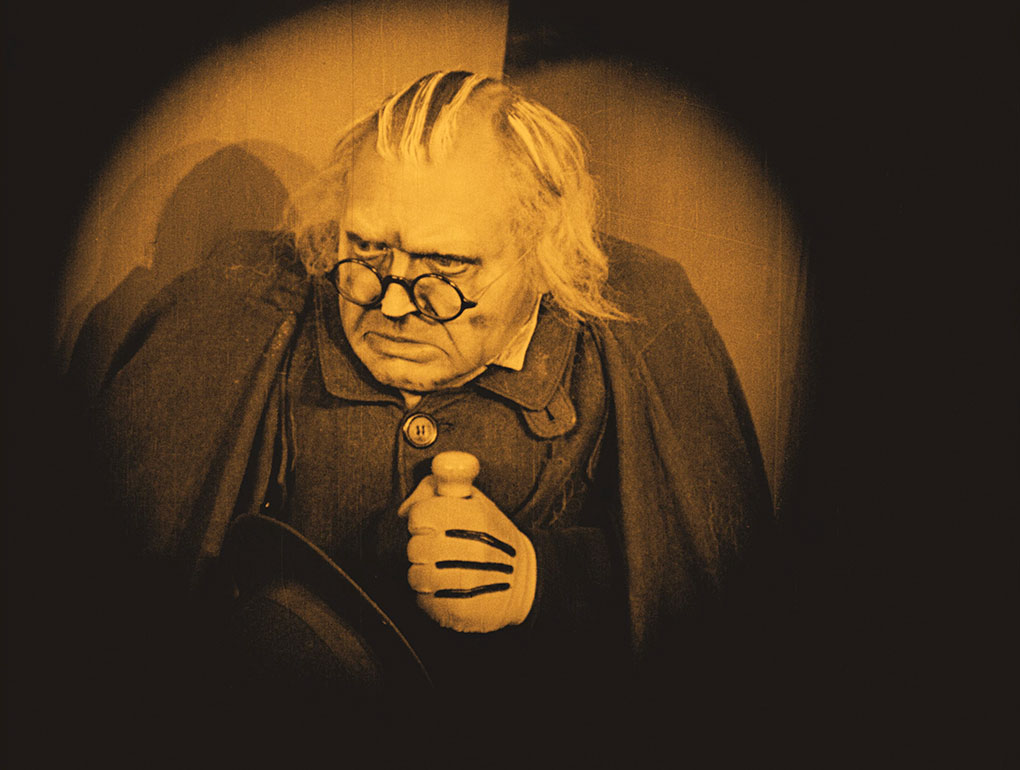
And so begins the flashback that comprises the bulk of the film's narrative, one that, if we're being picky, includes some scenes to which our storyteller could not have been privy. In the first, the Dr. Caligari of the title (a wonderfully sinister Werner Krauss) is seeking a permit from the foul-tempered Town Clerk to present an exhibit at the local fair. A short while later he's outside his tent and barking up business for his very particular sideshow. Propped up inside a coffin-like cabinet on a stage in front of a crowd of the curious is a black-dressed somnambulist, a term not commonly heard in this day and age that is generally defined as someone who walks in their sleep. This one, named Cesare (a superb Conrad Veidt), would have little option, since he has apparently been in a state of sleep for most of his life, but when awoken he knows every secret and can predict the future. In order to demonstrate this talent, Caligari rouses Cesare and invites the onlookers to test him. In the audience is Franzis and his close friend Alan (Hans Heinrich von Twardowski), the latter of whom immediately rushes forward and blurts out the one question I'd never ask anyone with such an ability: "How long will I live?" "Till the break of dawn," the somnambulist portentously replies. An easy claim to dismiss, you might think, but there's a murderer on the loose, and who can predict where he might strike next?
It turns out that Franzis and Alan are rival suitors for the affections of the lovely Jane (Lil Dagover), who is soon to decide which of the two she will marry. Whomever she chooses, both men pledge that they will remain friends regardless, good intentions that are scuppered when Alan is murdered in his bedroom that night. Severely shaken by the death of his friend, Franzis enlists Jane's help to investigate Caligari, who quickly finds other work for his shadowy sleepwalker.
Intriguing though the storyline is, particularly for a film with so few cinematic precedents (Paul Wegener and Henrik Galeen's 1915 Der Golem is the only title that comes instantly to hand, and that's a lost film), it's the execution that has earned The Cabinet of Dr. Caligari its seat in the royal box of film history. Even today the look of this film is genuinely startling – watching Caligari is a little like attending a retrospective exhibition of German Expressionist art, swallowing a small dose of reality altering drugs, and falling headlong into one of the paintings. There are no sets in the traditional sense, but physical outlines of buildings and their interiors whose features have been painted onto the floors and backgrounds. And these are not the sort of buildings or rooms that you're likely to have encountered anywhere in the real world. I'm sure I saw no more than four or five straight vertical or horizontal lines anywhere in the film – everything from windows and walls to houses, caravans and even chairs are sharply and impractically angular. Even light is painted directly onto the walls and floors in an approximation of how it might fall through such angular openings. This is a world pulled out of troubled dreams and redrawn by cubists, an externalisation of anxiety and fear so powerful that it has distorted the landscape.

The effect is extraordinary, imbuing every scene with a palpable sense of unease and (initially) inexplicable threat and creating a world in which the safety barrier of logic may well not apply. This carefully crafted air of artificiality is enhanced by the design-driven decision to film each scene from only one or two specific angles, shots whose mise-en-scène is every bit as crucial as the action that takes place within it. Take another look at that definition at the top of the review. The impact of Expressionism can be keenly felt throughout early German and even Hollywood cinema and its legacy lingers to this day. But nowhere will you find a purer cinematic representation than The Cabinet of Dr. Caligari, a sublime marriage of avant-garde and narrative cinema in which almost every shot is a gallery piece in its own right.
With all copies of the aforementioned 1915 Der Golem now lost to history and J. Searle Dawley's 1910 Frankenstein also a lost film until relatively recently,** Caligari is free to stake its claim as the film that effectively gave birth to the horror genre, pre-dating F.W. Murnau's seminal Nosferatu by two years. The influence on subsequent genre works on both sides of the Atlantic has been well documented, and can even be clearly seen even in far later films such as Henry Selick and Tim Burton's The Nightmare Before Christmas and Martin Scorsese's Shutter island, and the distinctive visual style is directly referenced in a cut scene from Tom Gormican's The Unbearable Weight of Massive Talent. Throughout its running time it sets precedents for genre films to come. The scene in which Cesare breaks into Jane's bedroom and carries her off is instantly recognisable from any number of film adaptations of Frankenstein or Dracula, and the approach of Alan's murder as a sinister shadow prefigures one of the most famous sequences of Nosferatu. The image of Cesare being woken and walking slowly and mechanically forward, observed with obsessive eagerness by the wild-eyed Caligari, meanwhile, plays almost like a template for the scene in Metropolis in which Rotwang first activates the Robot Maria.
Others are more qualified to talk about the film as a commentary on life in post-First World War Germany and its reading as an anti-authoritarian tract, but just about everyone seems to have an opinion on the framing story and how to interpret the final scene. I'm not about to go on a spoiler binge, but will suggest that the sequence is open to at least two very different readings, and that the commonly held view (oh I so want to get into this) is nowhere near as clear cut as some have suggested. Speaking personally, the reading persuasively presented by David Kalat on his commentary track is not only more interesting but a lot more chilling, and adds to the sense that The Cabinet of Dr. Caligari was a film at least thirty years ahead of its time.
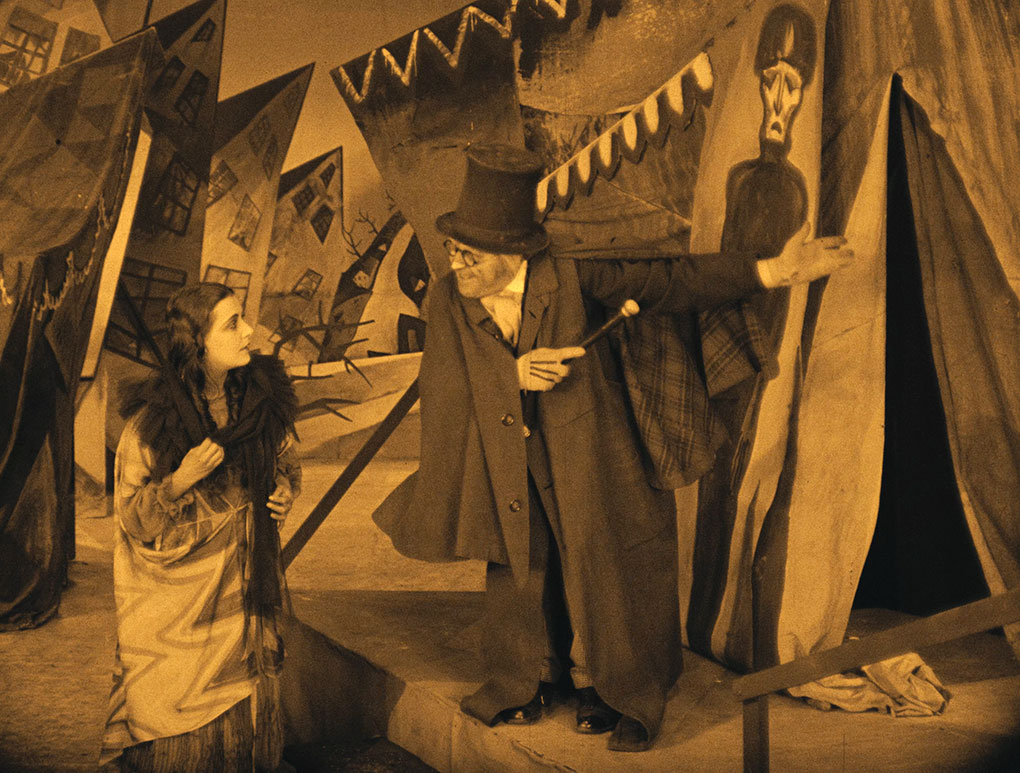
When I first revisited the film on Blu-ray back in 2014, particularly looking as good as it did in this restoration, it stirred in me a response I'd not experienced for some time, one I found myself re-experiencing when watching again on UHD. As the camera frames Cesare in facial close-up and he opens his eyes for the first time (even his black eye make-up is angular!), I was briefly transported back to a time when, for seventy or eighty mesmerising minutes, I really could believe that an Egyptian mummy could rise from the dead, or that a creature made from parts of dismembered corpses could be brought back to life. For just a few glorious moments I was a child again, and able to enjoy that very unique chill that only old school black-and-white horror films were ever able to provoke.
If you have the 2014 Masters of Cinema Blu-ray release of the film, you'll already have seen the 4K restoration from which the transfer on this new UHD edition was sourced, the difference being, of course, that on that disc it was downscaled to 1080p, whereas here it is presented in its full 4K resolution. Another viewing of the restoration featurette detailed below reminded me of just how monumental a task it must have been to repair the worn and damaged source material and restore it to the quality on display here. As the opening text states, "The 4K restoration was undertaken by the Friedrich-Wilhelm-Murnau-Stiftung in Wiesbaden from the original camera negative held at the Bundesarchiv-Filmarchiv in Berlin. The first reel of the camera negative is missing and was reconstituted using alternate sources. Jump cuts and missing frames in 67 shots were reinserted from multiple prints."
Because it was drawn from the same source, all of the strengths of the Blu-ray transfer are also on very clear display here, with the sharpness and level of detail evident in many shots genuinely astonishing for a film that is now over a century old and formerly in a degraded state. The projected film print's use of colour tinting has been reproduced using two surviving nitrate prints from Latin America as reference, and the impact this sometimes has on the sharpness of such transfers feels less pronounced here than it did on the Blu-ray. Indeed, detail in the image is always clearly rendered, something particularly evident in sequences where the colour tinting is at its mildest, and maybe it's just me, but the image feels just a little richer and more vibrant here, despite the fact that no HDR appears to have been applied (if it has, my TV couldn't detect it). Unsurprisingly, traces of the former damage still remain (faded evidence of multiple scratches are common), and tend to be slightly more visible at this resolution, but as with the Blu-ray, dust spots and more serious damage is now rare, and the image sits rock solidly in frame. A superb presentation of an astonishing restoration.
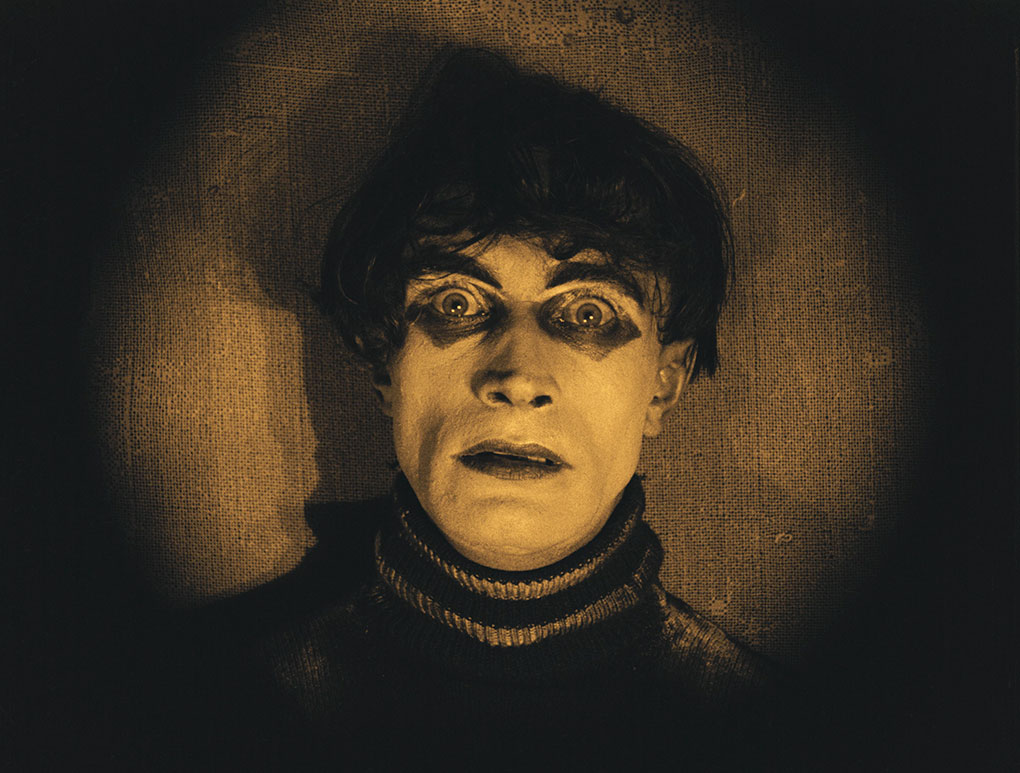
There are three audio tracks available showcasing two separate scores. The music track that accompanied the film on its 2014 Blu-ray release – by various composers and art directed by one of them, Cornelius Schwer – is presented both on Linear PCM stereo and DTS-HD Master Audio 5.1 surround. As with that earlier disc, both sound terrific, though the DTS track just has the edge when it comes to the bass response. Also included on this release is a 2019 score by Uwe Dierksen and Hermann Kretzschmar, which is presented in Linear PCM 2.0 stereo, and is sonically every bit as clear and dynamic as the Schwer tracks. It's hard to choose a favourite here – both are piano led orchestral tracks, both amplify the film's pervading sense of unease and menace, and both have their persuasively sinister passages. I'm happy watching the film with either.
Optional English subtitles are provided to translate the in-film German text and the expressionistic intra-titles.
Audio Commentary with Kevin Lyons and Jonathan Rigby
The reliable team of Euro Gothic: Classics of Continental Horror Cinema author Jonathan Rigby and Encyclopaedia of Fantastic Films and Television website editor Kevin Lyons take an enthusiastic and knowledgeable dive into what they describe up front as "an extraordinary, landmark film." They note that practically everyone who worked on it has a different story about who did what, the epicentre of which is the disagreement over who was behind the expressionist visuals, a question that seemingly every contributor to the special features seems keen to address. There's background information on the filmmakers and actors, various future horror motifs are identified, a contemporary review is quoted from, the music specified to accompany screenings by its American distributor is revealed, and the sheer scale of its influence on both horror and film noir is amply communicated. They shower praise on Conrad Veidt's facial acting as he wakes from his slumber, describe Caligari as "a revolting creature," and Rigby notes that, "the film is willing to flirt with absurdity, as the best horror films are." There's so much more here. Terrific
Audio Commentary with David Kalat
Carried over from the previous Masters of Cinema Blu-ray disc is this excellent commentary by author and film historian David Kalat, and despite the commissioning of the new commentary above, this remains an essential extra. Not only does Kalat really know his stuff, he's a hugely entertaining raconteur and is always brimming with enthusiasm for his subject. He covers a sizeable amount of ground in the course of the film's 77 minute running time, including the development and production of the film itself, who was responsible for its unique look, its influence on Universal's gothic horror features and international commercial success, and a whole lot more. I was intrigued to discover that the film's love triangle grew out of the fact that scriptwriters Carl Meyer and Hans Janowitz were also in love with the same woman, an actress who at one point was slated to play Jane. Kalat also provides some interesting background on Weimar Germany, and gives a detailed breakdown of the thinking behind the Expressionist movement. And this is just a sampling of the subjects covered. Another superb companion to the film.
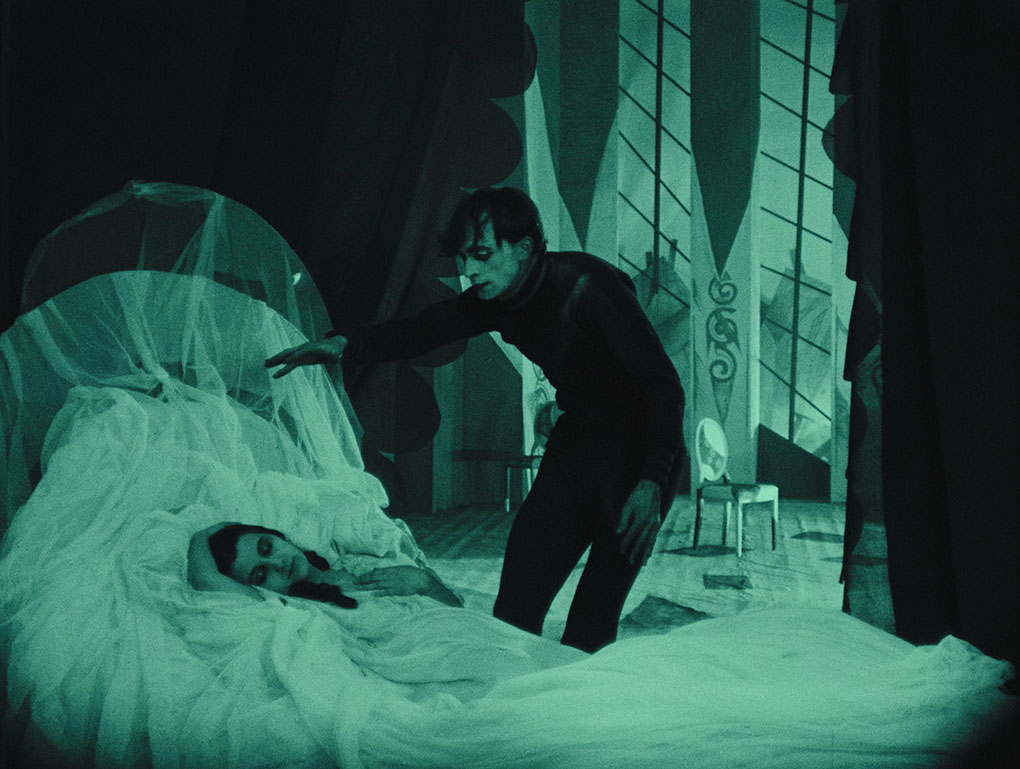
The Asylum in Film (14:16)
What would a modern UK genre disc release be without a contribution from Kim Newman? Here he takes a breezy and entertaining look at the presentation of asylums in film, including cinema's penchant for presenting psychiatrists and asylum heads as unhelpful at best and evil at worst. He identifies Edgar Allan Poe's 1845 blackly comic short story The System of Doctor Tarr and Professor Fether as the single most important piece of fiction about asylums, and Alan Clarke's 1975 TV play Funny Farm as probably the only realistic cinematic portrayal of what was then known as a mental hospital. He also claims that the reason we all dread is the final shot of Alfred Hitchcock's Psycho is because of its suggestion that it's we who are the crazy ones.
You Must Become Caligari (15:40)
Clips from the film are used to illustrate an enjoyable verbal essay by David Cairns, one that examines the various claims made about the origin of the film's distinctive style, and explores specific elements of its narrative, characters, and approach to storytelling. Interesting throughout, it also offers an intriguing alternative reading of the final sequence, which Cairns suggests begins earlier than you might think.
Caligari: The Birth of Horror in the First World War (52:53)
A German language documentary, directed by Rüdiger Suchsland, that provides a useful history lesson for those not well versed in Germany's journey from the pre-WW1 Kaiser era to the Weimar Republic. There's a ton of fascinating archive film material and plenty of clips from the movies under discussion. Key art movements of the period are outlined, and specific information on Caligari and other German Expressionist films of the era is provided. Another first rate extra.
On the Restoration (8:47)
A special feature of two distinct halves. The first is a handsomely photographed promo for the fine work done by the restoration team, one that concludes with a plea for public funding for their cause. The second begins by showing three stages of the restoration, then offers a welcome chance to compare shots from this new restoration side-by-side with its pre-digital 1984 equivalent. The improvements are significant, in picture stability, the clean-up of damage and dust spots, and particularly the tonal range, which brings out far more detail in darker areas and corrects previously burned out whites. Even the clarity of the expressionistic intra-titles has been greatly enhanced.
Re-Release Trailer (1:29)
A solidly assembled Masters of Cinema trailer for the 2014 4K restoration of the film.
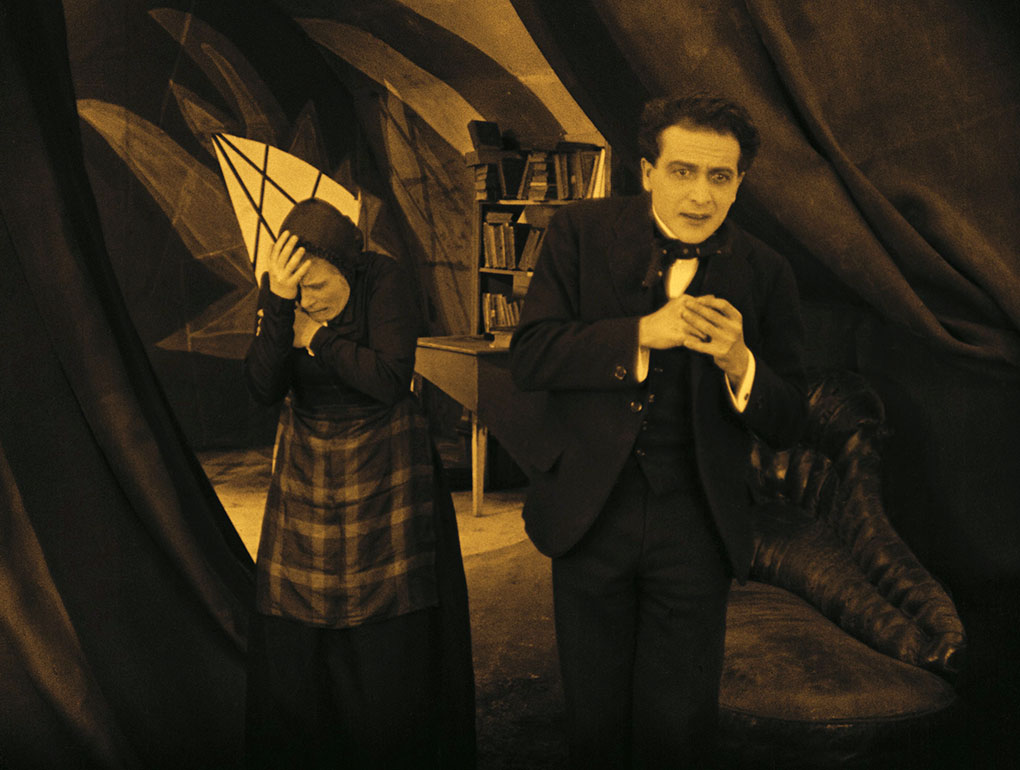
Also included is a 90-page Book, which kicks off with the main credits for the film, then moves on to a fascinating essay titled The Beginnings of Expressionist Film by Lotte H. Eisner, who also tackles the conflicting stories over who was behind the distinctive set design, before delving into the film's expressionist content and themes. Also getting under the surface of the film is Frank Tomasulo in his weighty essay, The Cabinet of Dr. Caligari: History / Psychoanalysis / Cinema, which examines how Weimar Republic Germany attempted to signify itself through the film, and explores the notions of Caligari as Hitler, as Freud, and as a filmmaker. Again, this makes for enthralling reading. Up next are extracts from American Cinematographer magazine that examine the impact of expressionism on German cinema during the 1920s and 30s, and the emigration of many of the filmmakers to Hollywood. A brief contemporary review from Variety is followed by detailed credits (four pages' worth!) for the restoration, and the usual notes on viewing.
A masterpiece of silent cinema, one that gave birth to both the horror film and the art film and whose influence on later works is incalculable, presented here in its 2014 restoration but in glorious 4K and looking better than it ever has. If you have the Blu-ray, the decision on whether to upgrade may depend in part on your ability to play and view UHD discs and the size of your screen (or indeed, the one you may plan to upgrade to at a later date) – the larger the screen, the more you will appreciate this new transfer. If you never got around to buying the Blu-ray, meanwhile, this is now the one to go for. Highly recommended.
This review has been updated from my 2014 Blu-ray review of the same film.
|